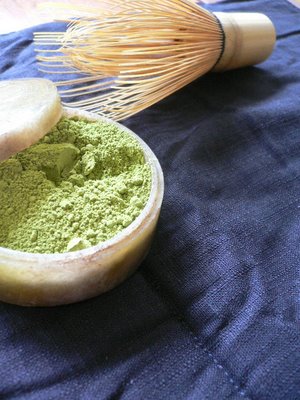 This is one of the highest form of tea making. This technique, making tea with green tea powder in a black bowl with a bamboo wisk was invented during the Sung dynasty, but its use disappeared in China. Luckily, Japan adopted it and gave this tea the name matcha, similar to the Chinese 'Mo' (grinded) 'Cha' (tea).
This is one of the highest form of tea making. This technique, making tea with green tea powder in a black bowl with a bamboo wisk was invented during the Sung dynasty, but its use disappeared in China. Luckily, Japan adopted it and gave this tea the name matcha, similar to the Chinese 'Mo' (grinded) 'Cha' (tea).What makes Sung dynasty tea so special?
For Teaparker, it's the symbiosis between aiming for the best smell and taste, as well as for the nicest display. The black Tian Mu Wan (tenmoku in Japanese) plays a central role. It's black color is most fitting the light green cream that forms on the surface on the bowl.
A Tian Mu Wan are made of black clay from Zhen Yang, Fujian. It is than glazed with a thick layer of black glaze that will help to retain the heat. One of the most fascinating thing then happened: some bowls displayed natural changes of color on the glazing. First it happened by accident, then potters learned to create these variations.

As for the tea that is used, just have a look at the prices of high quality Japanese matcha, and you'll understand that this tea is made from the finest, most tender tea buds and then processed to keep it as fresh as possible. Only Japanese matcha can be used for Sung dynasty tea. Chinese/Taiwan green tea powder is just green tea that was grinded and is not fresh/high quality enough for this method.

So, how do you make Sung dynasty tea?
1. clean your hands,
2. clean your Tian Mu bowl and the bamboo spoon with a dedicated, clean and beautiful fabric,
3. Slowly pre-heat the bowl with just boiled water and then empty the bowl,
4. Put several spoons of matcha up to the zhi kou (the height where the glaze stops on the outer walls of the bowl). Usually just a few millimeters.
5. Add some just boiled water (95 degrees Celcius +) as slowly as possible. Take the bamboo whisk and mix water and tea.
6. Repeat step 5 several times (ideally 7 times)
7. Slowly take the wisk out when a layer of foam floats on the surface. Tea is ready to drink.
8. Rinse and clean the wisk, the spoon and the bowl with hot water. Let them dry before storing them away.
The most difficult about this technique is how to handle the wisk. From your movement depends the taste of your tea. I have been learning with Teaparker recently. I was amazed at how different poorly wisked matcha (I made in my first attempts) tastes compared to the one Teaparker makes. Here are 2 links to videos of Teaparker making this tea.
Some principles for handling the whisk:
- Never stop until it's over. Foam will only happen at very high temperature. If you stop, then you loose time and your chances for success diminish,
- Don't move the whisk up and down: you would break some branches
- Try to keep more or less the same speed and the same direction,
- Use your whole body to make this happen. Think of this like a way to channel your energy into the tea bowl. A clear and happy mind will produce a good tea.
- The final result must be a thick layer of fine foam covering the whole surface. And it should be even thicker in the middle, where you took the whisk out.
- Sweating is almost garanteed.
It takes several months of practice to master this technique. Good luck!

I will continue my practice! Difficult indeed. Did in Song Dynasty have different whisking techniques as in chado?
ReplyDeleteTeaparker teaches the technique that emperor Song Huizhong has described in his tea book. He probably wanted to write an authoritative book in order to tell people what the proper way of preparing such tea should be.
ReplyDelete